Propagating plumerias is a great way to expand your collection, or share your favorites with friends.
In this post, I’ll talk about the different methods, tell you when and how to take cuttings, and then show you how to root them, step-by-step.
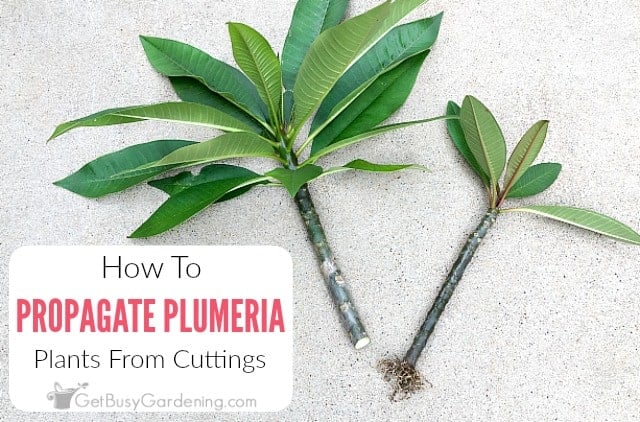
Though it sounds like it would be difficult, plumerias (aka: frangipanim, kalachuchi, or Hawaiian lei tree) are surprisingly quick and easy to propagate.
Below I’ll talk about the different methods you can try, and then dive into all of the information you need to know, including my best tips for success.
It’s fun and addicting once you learn how, and I’ll walk you through the exact steps in this detailed guide for propagating plumerias.
Can You Propagate Plumeria?
Over the years a lot of people have asked me “can I grow plumeria from a cutting?“. Well, I’m sure you know by now that the answer to that question is YES!
Since I’ve been asked that so many times, and I have several years of experience doing it myself, I finally decided to write a step by step tutorial on how you can do it too.
Plumeria Propagation Methods
There are two main ways to propagate plumerias: from seed or by rooting the cuttings.
In this article, I will show you how to grow plumeria from cuttings. I’ll save the seed starting for a future post.
I know it sounds scary, but it is actually pretty easy. First, let’s talk about when is the best time to try it.
When To Take Plumeria Cuttings To Propagate
The best time of the year to take plumeria cuttings for propagation is in the warm spring and summer months, especially when it’s humid outside.
If you take them too late in the summer, or in the fall as the mother plant is starting to go dormant for the winter, then they probably won’t root, or it will be much slower.
Rooting Plumeria Cuttings In Winter
Plumerias go dormant during the winter, so if you take the cuttings too late, they will likely won’t root. However, if you store them correctly, you can overwinter them until spring.
Just wrap the cutting with paper, or leave it in the pot and keep the soil completely dry. You can mist it every once in a while if you want, but don’t overdo it or it could end up rotting.
Then in early spring, give it a good, deep drink, and follow the step by step instructions below for rooting it.
How To Cut Plumeria For Rooting
There are a few things you’ll want to keep in mind when cutting plumeria stems and branches for rooting.
It doesn’t make a difference where you cut it, so it’s just a matter of how big or small you want it to be. You can root any size cutting, but you’ll have the best chance if it’s at least 3-4″ long.
But you do want to be sure to use a sharp pair of pruners, and always sterilize them so you get a nice clean cut.
Also, plumerias are very prone to tip rot, so it’s extremely important to always make your cuts at a downward angle so that water can’t settle into the wound.
How To Grow Plumeria From Cuttings
Before you get too excited and stick your plumeria cutting directly into the dirt, there are a few steps you’ll need to take to prepare it for the best chance of success.
First, remove the leaves from the cutting. This will allow it to put all of its energy into producing new roots, rather than maintaining the foliage.
Second, be sure to allow the wound to cure (dry out) before you attempt to root it. This step is super important, so don’t skip it, otherwise your plumeria cutting will likely rot instead of forming roots.
To do that, simply let it sit in a dry place until the wound is completely callused over. This can take several days to over a week, so be patient, and don’t rush it.
Related Post: How To Grow Plumeria In A Pot
Rooting Plumeria Cuttings In Water
Another common question I get asked is “can I root my plumeria in water?“. The short answer is yes, technically it is possible.
However, rooting frangipani cuttings in water isn’t always a huge success. Many times, the stems will only rot.
If you have plenty of extras to work with, then by all means experiment with this method. It’s always fun to try something new.
My preferred plumeria propagation method however is rooting them in soil. So, I’ll stick to that for now.
Planting Plumeria Cuttings In Soil
The best soil for rooting plumeria cuttings (also called “medium”) is one that is very quick-draining and doesn’t hold much moisture.
I make my own by combining equal parts of perlite, potting soil, and coarse sand, but you can use a commercial mix instead.
When planting a plumeria cutting in soil, it’s very important that you always use a clean pot to avoid any type of contamination.
Also, make sure you don’t use a huge container for rooting each cutting, otherwise you risk overwatering, which will only cause it to rot.
I use 4″ pots for rooting most of mine, and once in a while I might go up to a 6″ one for larger stems or branches.
Related Post: How To Choose The Best Plumeria Soil
Plumeria Cutting Care While Propagating
For the best chance of rooting, keep the air around your plumeria cutting humid, but the soil on the dry side.
If you live in a humid climate like I do, you don’t need to do anything special. Simply leave it outside, and soon it will root. Just be sure to keep it out of the full sun until then.
But, if you live somewhere dry, or you’re trying to root one indoors, then it’s a good idea to mist it every couple of days with a plant sprayer.
Just don’t water the soil, you want that to stay on the dry side. If it’s too damp, it will only cause your plumeria cutting to rot, and you don’t want that.
You’ll know your cutting has successfully rooted once you see new leaves forming the top.
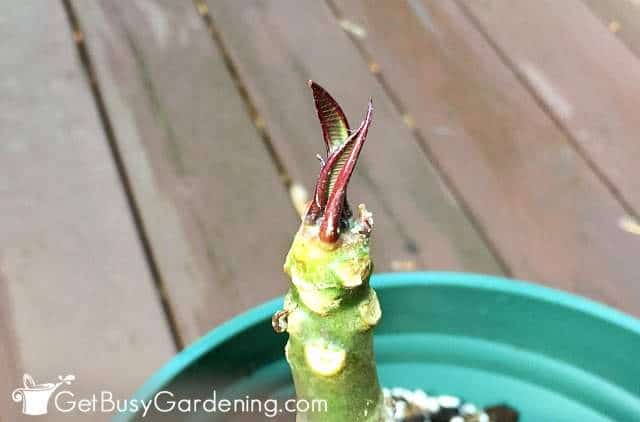
How Long Does It Take Plumeria Cuttings To Root?
How long it takes for plumeria cuttings to root depends on the environment. But in the right conditions, the roots will start forming in as little as 2-3 weeks.
However, if it’s really dry, wet, or too cold, then it will take much longer. For the fastest results, keep them in a bright, warm, and humid location out of the direct sun.
Why Is My Plumeria Not Rooting?
Your plumeria may not be rooting due to over or under watering, lack of light, or the temperature is too cool.
The soil needs to be kept on the dry side at all times, and it should never be wet. A moisture meter can help you maintain the perfect balance
Also, the roots will form best when it’s between 75-85°F. You can use a heat mat placed under the pots to speed things up.

Transplanting Plumeria Cuttings After Propagation
Once your plumeria cutting has several mature leaves, then you know it’s propagated and ready to move into a new pot or the ground.
You certainly don’t need to worry about transplanting your kalachuchi cutting right away, you can leave it in the small container until it becomes pot-bound if you’d rather.
The best potting soil to use is a porous fast-draining mix, and you should always plant them a container that has drainage holes.
Or you can try to make your own by mixing coarse sand and perlite or pumice with general potting soil.
Once your new baby has become established, you can start fertilizing it to encourage flowers, the cuttings can bloom their first year.
Related Post: How To Care For Plumeria Plants (Hawaiian Frangipani)
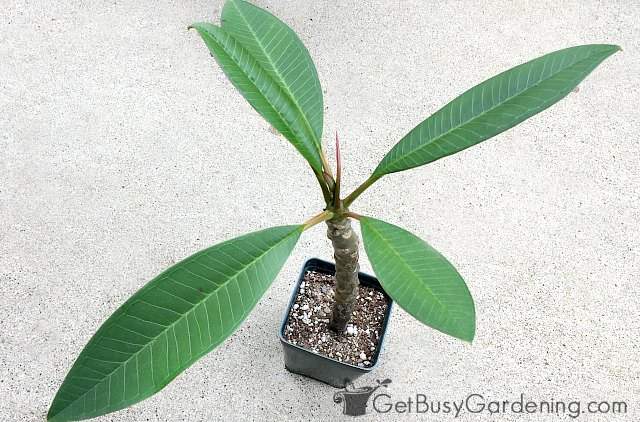
Plumeria Propagation FAQs
Below I’ll give you answers to the most frequently asked questions about rooting plumerias. If you can’t find what you’re looking for here, add a comment below.
Can You Replant A Broken Plumeria Branch?
Yes, with some care, you can replant a broken plumeria branch. Make sure the branch is dry and not rotten. If the broken end is mangled or crushed, then cut off the damaged parts so you have a clean edge. Clip off the leaves, and leave it to dry in a shady place for a few days. Then follow the steps below to root it.
How fast do plumeria cuttings grow?
Plumeria cuttings can grow very fast in the right conditions. It can take as little as 2-3 weeks for the roots to start forming.
How long do plumeria cuttings last?
Plumeria cuttings can last several months without being planting. However, they will slowly start to shrivel over time, so the sooner you root them after they’re properly callused, the better your success rate will be.
Can frangipani be propagated in water?
Yes, frangipani can be propagated in water. However, it’s not the best method to use, as the cuttings can easily rot. It’s a fun experiment to try if you have extras, but for the greatest chance of success, I recommend rooting them in soil.
Can you plant a fresh plumeria cutting?
While you can plant a fresh plumeria cutting, I highly recommend you let dry and fully callus over first. If you try planting it with a fresh cut, it has a much higher chance of rotting rather than rooting.
Plumeria propagation by cuttings sounds like it would be really hard, but it’s actually pretty easy when you follow these steps. It’s really fast too, so once you get the hang of it, you’ll have plenty of new starts to share with friends!
If you want to learn how to multiply any type of plant you can get your hands on, then my Propagation Made Easy eBook is for you! It has everything you need to know in order to start propagating your favorites right away. Download your copy today!
More Plant Propagation Posts
- The Best Plant Propagation Tools, Equipment & Supplies
- Plant Propagation: A Detailed Guide For Beginners
- How To Propagate Aloe Vera By Division
- Propagating Christmas Cactus From Cuttings Or By Division
- How To Propagate Banana Plants
- How To Propagate Snake Plant (Sansevieria) In Water Or Soil
Share your plumeria propagation tips in the comments section below.
Step By Step Instructions
How To Propagate Plumeria Cuttings

Rooting plumeria cuttings is easy once you know the right way to do it. Follow these detailed step by step instructions for the best results.
Instructions
- Take and cure the cutting - Use a clean pair of sharp pruners to take 3" or longer plumeria stem or branch cuttings. Then place them in a dry location out of direct sunlight for at least a week, or until the wound has callused over.
- Prepare the rooting medium - Use a commercial fast-draining medium, or try mixing equal parts of regular potting soil with perlite and coarse sand. If it's bone dry, dampen it slightly. Then use your trowel to fill the pot.
- Apply rooting hormone - Dust the callused end of your plumeria cutting with rooting hormone. This will help it produce strong, healthy roots, and also make the process faster.

- Plant the cutting - Make a hole in the medium that’s deep enough so the cutting will stand up on its own. Put the cut end into the hole, and gently pack the soil down around the base. The roots will sprout out of the bottom of the stem, so you don't have to plant it very deep.

- Place somewhere warm and bright - Put your cutting in a humid location with bright light. Placing it on top of a heat mat can speed things up, but it’s optional. Once you see new leaves on top, that means your frangipani cutting has rooted. You can pot it up into fresh soil if you want, but only go one size larger than the current container.
Notes
- The larger your cutting is, the longer it should cure. You'll know it's ready when the cut feels dry and hard. Do not skip this step or it may end up rotting.
- While your plumeria cutting is rooting, keep the medium on the dry side. If it’s too wet, the cutting will likely rot. You can use a moisture gauge to monitor it.
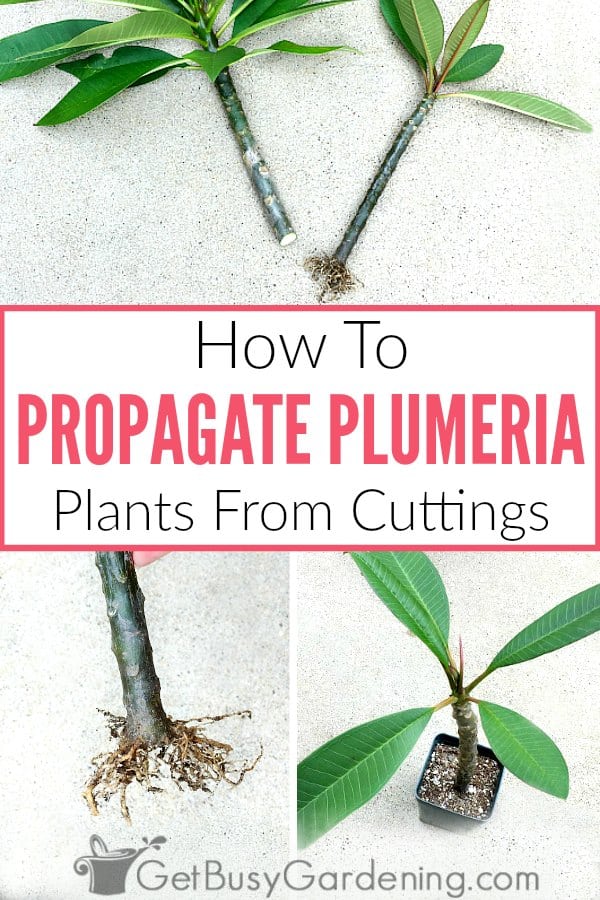
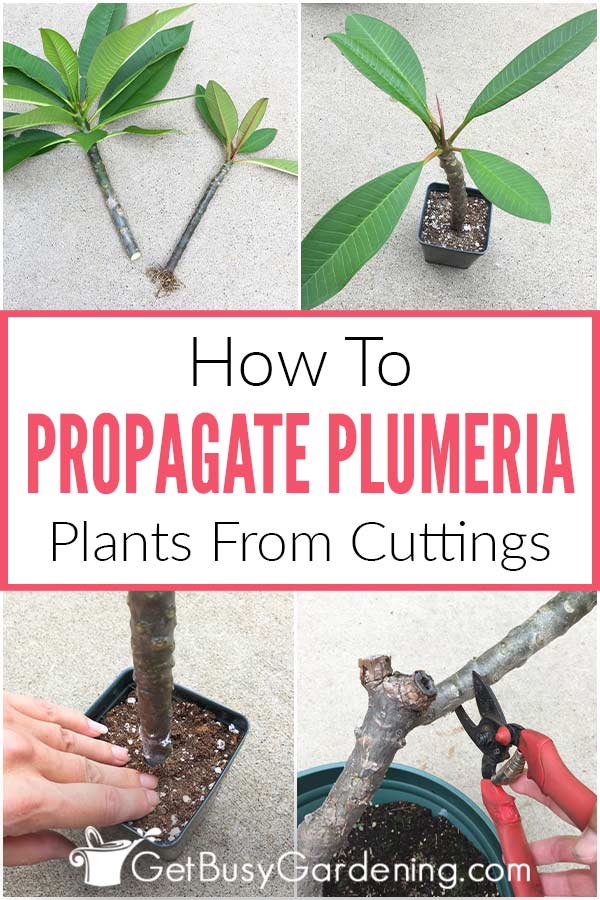
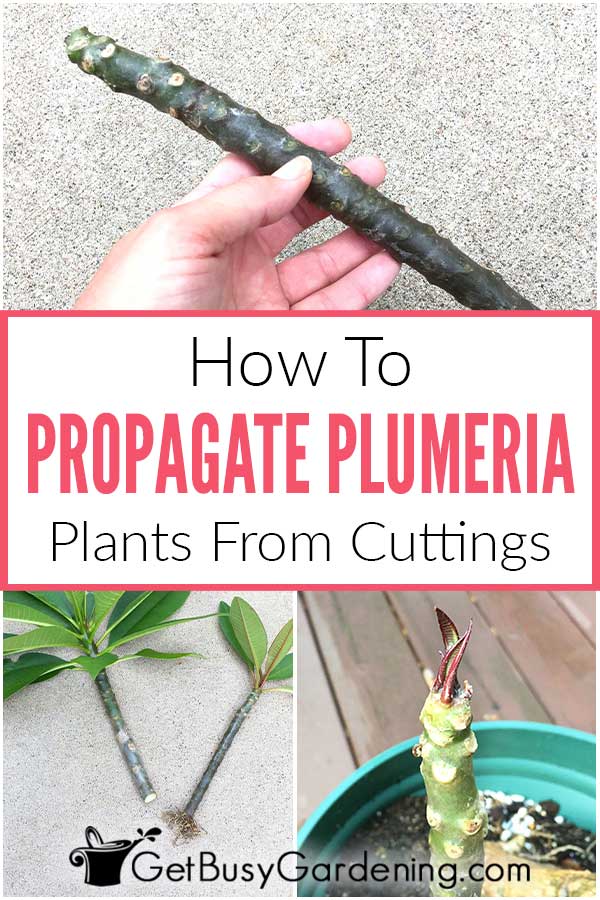

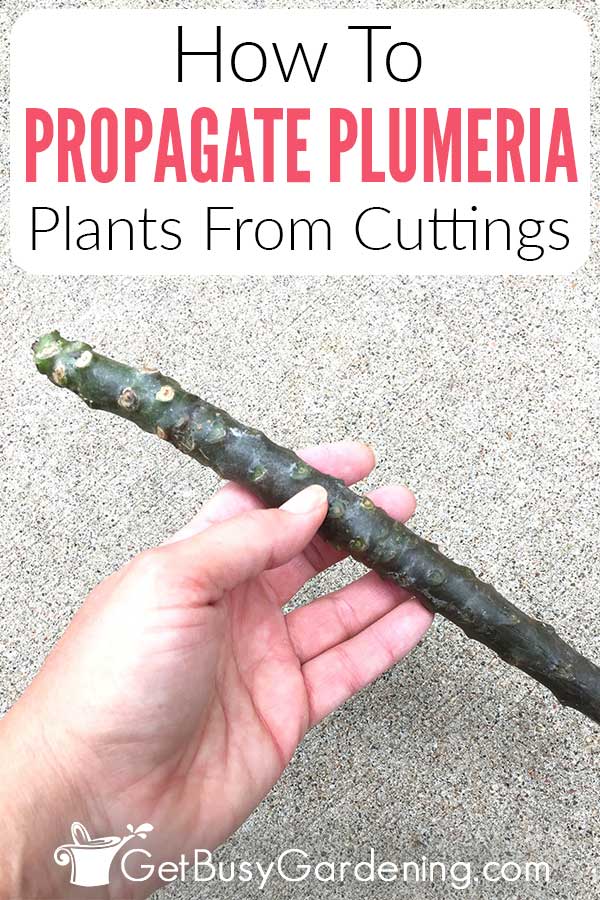

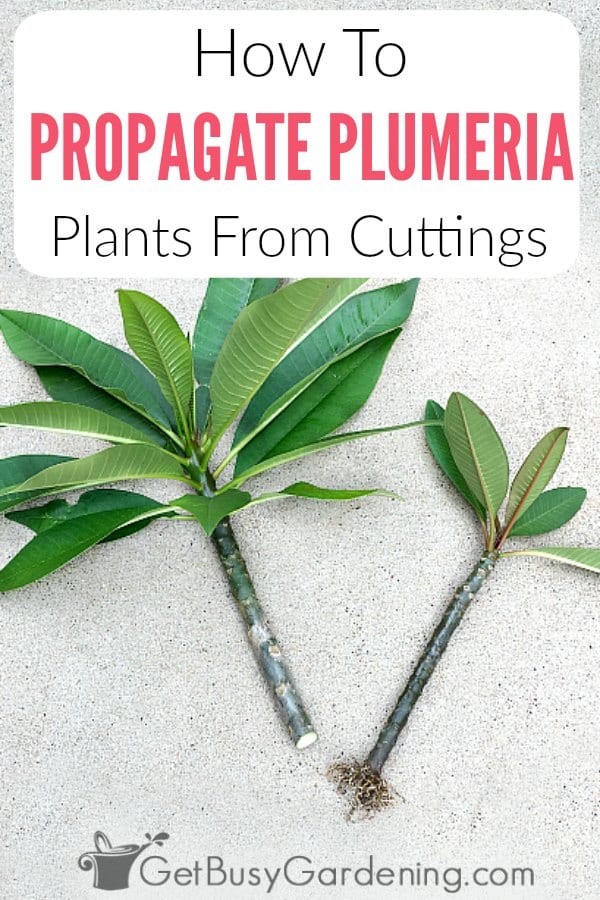

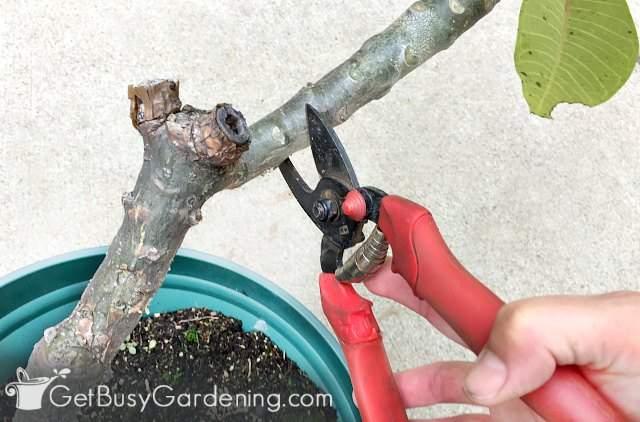
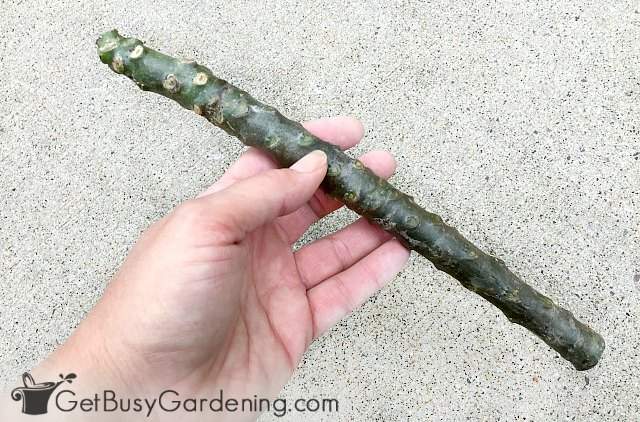


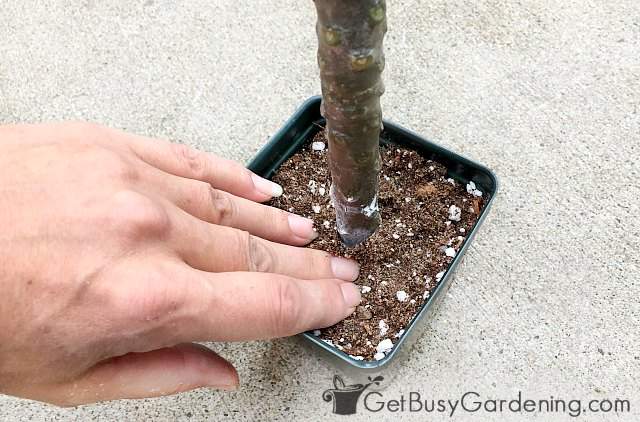

Debbie says
Hey I was just wondering if you have any idea why my plumeria has never bloomed.it’s in a pot because I live just below Atlanta ga. It grows to about 5 feet. Its always looks healthy. I’ve never used the fertilizer that you recommended. I will be getting some next trip to home depot. I pretty much use an all purpose fertilizer like miracle grow. You think that could be the reason? Thanks for the great info!
Amy Andrychowicz says
Fertilizer is definitely important in order to get plumerias to flower. I don’t recommend using chemical fertilizers like the one you mention, because they strip nutrients out of the soil over time, and can cause major damage to plants. I recommend using a natural, organic type that will feed the soil, which will result in a much healthier, blooming plant. Here’s a post that’s all about growing them, and has tips for getting them to flower too… How To Grow Plumeria Plants.
Matthew MacKenzie says
Hi Amy. I love your website; your instructions are very clear and easily to follow. I have grown a plumeria from seed and it is now five years old. It is about 60cm tall but has not branched out or flowered yet…probably because I live in the UK. It is kept indoors during the winter but this year the stem has gone soft at the tip. Any advice? Should I cut the tip off?
Amy Andrychowicz says
Wow, you are one patient person to grow a plumeria from seed! That takes a long time! Sorry to hear the tip is soft. Unfortunately plumerias are very susceptible to tip rot, and it’s a very common problem. You should definitely cut off the rotting parts, or it will just spread and kill the whole plant. The good news is that, after you prune off the rot, your plant will branch out from the cut. Always a silver lining, right! 🙂
Glenda says
Will the Mother plant continue to grow and put out more leaves after propagation?
Amy Andrychowicz says
Yes! The mother plant will grow new leaves just below the spot where you took the cuttings.
Corinna wallace says
I live in Tennessee, I have a few cuttings, I have them inside right now potted, I will put a humidifier in the room for some humidity because it’s still chilly outside and uncertain of rain right now. Would it be a good idea for a plant heat pad under them??
Amy Andrychowicz says
Yes, you could put a heat mat under your plumeria cuttings if they haven’t rooted yet. That will help to speed up the rooting process.
Debi Moore says
Hi Amy, THANK YOU!!
Your Plumeria tips were very,very timely and to the point! I really wanted to let you know that the info was greatly appreciated!!!
Amy Andrychowicz says
You’re welcome! Hope your plumeria cuttings will thrive for you. 🙂
Jaci Morris says
I have a plumeria that has a large curve in the stalk so it is constantly falling over. Can I just cut the branch to get the curve out??
Amy Andrychowicz says
Yes, you sure can. You can take plumeria cutting from any point on the stem.
Amy Wethington says
Hi,
Its October in florida and my neighbor gave me cuttings 2 weeks ago. I planted them in pots and some of them have growth already. Where is the best place to keep them in the winter? Right now they are outside, should I move them into my sunroom?
Amy Andrychowicz says
Oh wow, congrats on successfully propagating your plumeria cuttings, how exciting!! If it doesn’t get below freezing where you live, then they should be fine outside for the winter. Otherwise, yes, I would move them inside. But they do go dormant during the winter, so they don’t need much sun or water. Learn more about plumeria plant care (and dormancy) here.
Wren says
Hi there
My plumeria had a tip-over and branches broke off
I pruned the pieces and on the potted stalk.
The leaves had not fallen off yet.
I’m in Maryland so it’s fall now.
I was goin to bring in this week due to weather change. Is there anything special I need to do???
Amy Andrychowicz says
Yes. Here is a post that has detailed information about caring for plumerias, and also winter care and dormancy… How To Grow Plumeria Plants
Susan says
My 3 plumeria are quite leggy. They are about 4 feet high and are shaped like Ys. I started them 2 years ago at this time from cuttings and they bloomed my first Spring. This year no flowers, until now (mid Sept) I’m finally seeing some buds. I live in PA so will bring them indoors in a few weeks to go dormant in my basement, but I want to know about how I can make them bushier? I read some of the above, and if I prune should that definitely be in the Spring? And will that prevent flowers again next year?
I know I need to fertilize more (and it seems miracle grow isn’t what I should be using). I do have some homemade compost and also some mushroom compost, could I mix that in the soil? And should I do that now or in the Spring? One more question? How big of a pot would you recommend? they are currently in painted clay pots 8.5 in high, 12 inch diameter wide Thanks!
Amy Andrychowicz says
Yes, legginess is very common for plumerias. All of your questions are answered in my detailed plumeria plant care guide. So start by giving that a read. But in summary, don’t do anything with your plumeria now that it’s fall. Wait until spring to prune, fertilize, and/or repot it.
Dana says
I will say they are very forgiving. I had one in a pot for about six months when my little teething puppy ate it. I gave up on it and stuck it in a corner, and leaves came back out the next spring! (Puppy survived, too, by the way.)
Amy Andrychowicz says
Haha, too funny! I’m glad you didn’t throw the poor chewed up plumeria into the trash! And that the puppy is OK! Whew! Yes, they are very forgiving. My husband ran mine over with the car one year (!!!). I pruned off the smushed parts, and it grew back just fine. LOL!
George Randall Griffin says
Thanks for this great tip.
I will definitely get a bag of perlite so I can start 10 or more plumeria cuttings, which is what I’ll have this year……depending of course, pot size….
Amy Andrychowicz says
You’re welcome! I hope all of your plumeria cuttings will root and thrive for you!
Lupe says
I have 2 plumerias, they are now flowering. I’ve had them for two years.
I want them to branch out. What must I do?
Amy Andrychowicz says
Taking cuttings of your plumeria is a good start. That will help the plant to stay more compact and branch out. Also, check out my plumeria plant care guide for more information.
Todd says
We have a 3 tall plumeria stick. Tons of leaves but never flowers nor branches. Is there something I can do to encourage this?
Amy Andrychowicz says
Yes, plumerias are heavy feeders and need to be fertilized regularly in order to grow and bloom. Here’s a detailed article about how to care for plumerias that will give you all the info you need… Plumeria Plant Care Guide.
Bruce Morris says
Great article. I use perlite only. I have an 18” pot and fill it up with cuttings. The straight perlite insures me I can’t over water. When they root I transfer each one to a separate pot.
I teach a gardening class twice a year at our local library and the spring class we start plumeria cuttings.
Amy Andrychowicz says
Awesome, thanks for sharing your tips and experience with propagating plumeria cuttings. Sounds like a fun class! 🙂
Kai says
Do plumeria cuttings *need* humidity? Typically it is very dry here most of the year.
Amy Andrychowicz says
No, they grow just fine without a lot of humidity. In fact, if it’s too wet and humid, plumerias could start to rot.
Nancy Nowicki says
After cutting all the tips off that I want to propagate, how do I handle the original plant that was in a pot.
Amy Andrychowicz says
I’m not sure what you mean. There’s nothing special you need to do with your plumeria after taking cuttings for propagation. Unless you’re asking about repotting it?
Mary johnston says
I have taken off all branches of my frangipani for cuttings. The original plant is now bare. Will it grow more branches again or will it just die away. Thank you.
Amy Andrychowicz says
Your plumeria should start to grow new leaves right under the cuts. If it’s dormant right now, then it won’t start growing again until spring.